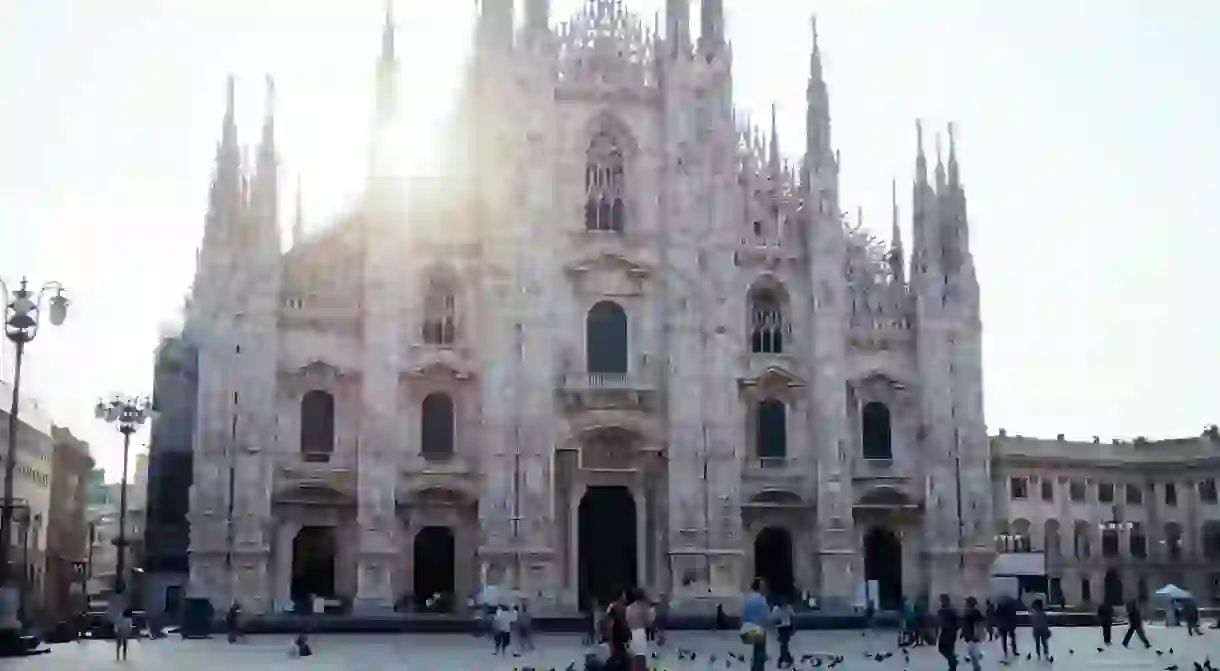Milan’s Duomo | A Timeline of Culture

Standing guard over Milan for more than 600 years, the Duomo has been a constant witness to the history of the city. It’s passed through countless rulers and reconstructions, from soft leather shoes striking the stone pavement around it to the tick-tack of heels and the ringing of cell phones. Today the Duomo is the most known silhouette in the city, though it took a long time to get to that point.
Construction of the Duomo was officially started seven centuries ago, in 1386, by Bishop Antonio da Saluzzo, but its vision truly grew with the support of Gian Galeazzo Visconti, Milan’s ruler of the time. In fact, the Duomo owes its signature pink-hued white marble to Visconti, whose grand ideas for the cathedral lead the architects to replace the originally planned terracotta stone with Condoglian marble from Lake Maggiore in the north of Italy. Canals were dug through the city to bring the marble from the Candoglia quarries to the construction site.

Unlike most Renaissance style churches that you’ll find in Italy, the Duomo of Milano is overwhelmingly gothic. Covered in dripping white spires and gargoyles, there’s no doubt about its architectural roots. Still, the sheer number of workers and the time that passed before it was completed mean that traces of neo-gothic and even romantic styles can be seen in the finished structure.

As Visconti embellished the cathedral’s original blueprints, architects and experts from all over Europe came to work on the structure, attracted by the ambitious project. At least 78 different head architects worked on the cathedral over the centuries, not to mention the thousands of artists, sculptors and specialised workers who were involved in the construction at one point or another. Major decisions were made among a team of technicians and other workers from a variety of backgrounds and cultures in an exchange of ideas and experiences, ultimately turning the Duomo into perhaps the most European of all the gothic cathedrals. As the plans grew and grew, construction continued to drag on. The cathedral was finally consecrated in 1418, though in reality only the nave was finished at the time, and after its consecration the Duomo remained incomplete for centuries. Politics, lack of money and indifference in a seemingly never-ending project (imagine a 100-year construction site) blocked any advances in construction.

More significant work was start in the 16th century when Archbishop Borromeo and his architect Pellegrini added their own influence to the style through the strict Catholic reforms introduced in that period, but it wasn’t until the 19th century that the final stages of construction were completed. It was only then that the façade was finally finished, spurred on by Napoleon during his time as ruler.

Although it’s easy to forget the long history behind monuments, the details and sculptures that cover the cathedral are enough to remind us of the sheer amount of sweat, time and money that went into making the building. In fact, there are 3,400 statues, 135 gargoyles and 700 figures on the massive structure! The best way to fully appreciate this is to climb to the terrace to see each in detail. You can climb the stairs or take the lift to the top, stepping out over the back of the Duomo into a large jail of elaborate spires and sculptures, stabbing into the blue sky with varying heights and strengths. On clear days you can see across Milan and out to the snow- peaked Alps in the north.

Following the marble path along the sides of the Duomo will lead you to the terrace. Only from there can you directly see the famous Milano Madonnina. The Madonnina is a four metre high golden statue of the Virgin Mary, symbol of the city and protector of the Milanese. Covered in 6,750 sheets of gold leaf gilding, it weighs over a half ton. The Madonnina was added before the façade was officially complete, raised as the highest statue on the structure in December 1774. Today Milan has passed a law stating that no new constructions can be higher than the revered statue.

Despite all the work, it can be argued that construction has never completely finished. A five- year project to clean the building was started in 2002 and routine restorations and cleaning are continually taking place to maintain the pristine white marble. Now over 5 million people visit the Duomo annually to admire one of the world’s oldest and biggest monuments. In such a cosmopolitan city, the Duomo stands strong, an anchor of its own rich history.














